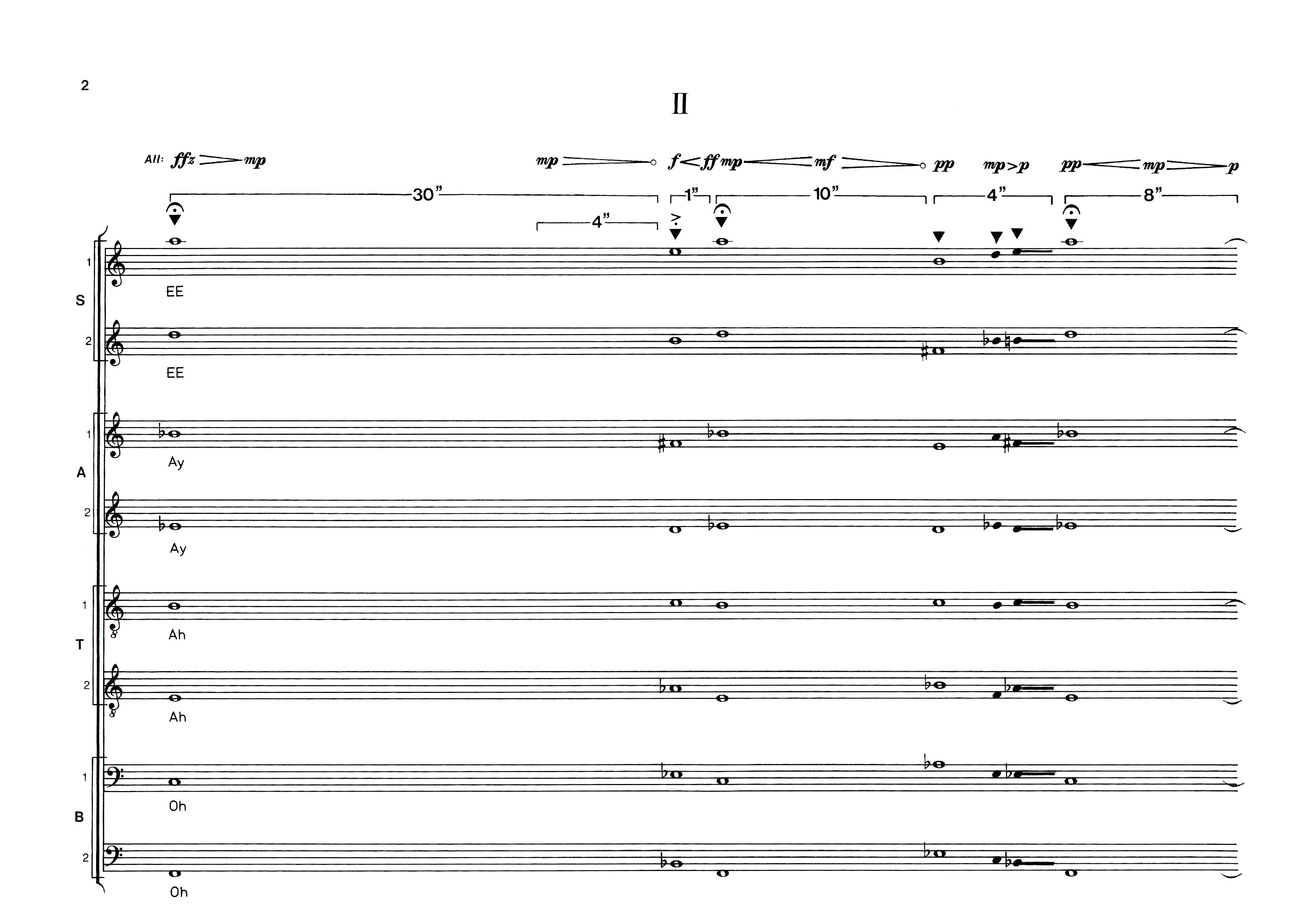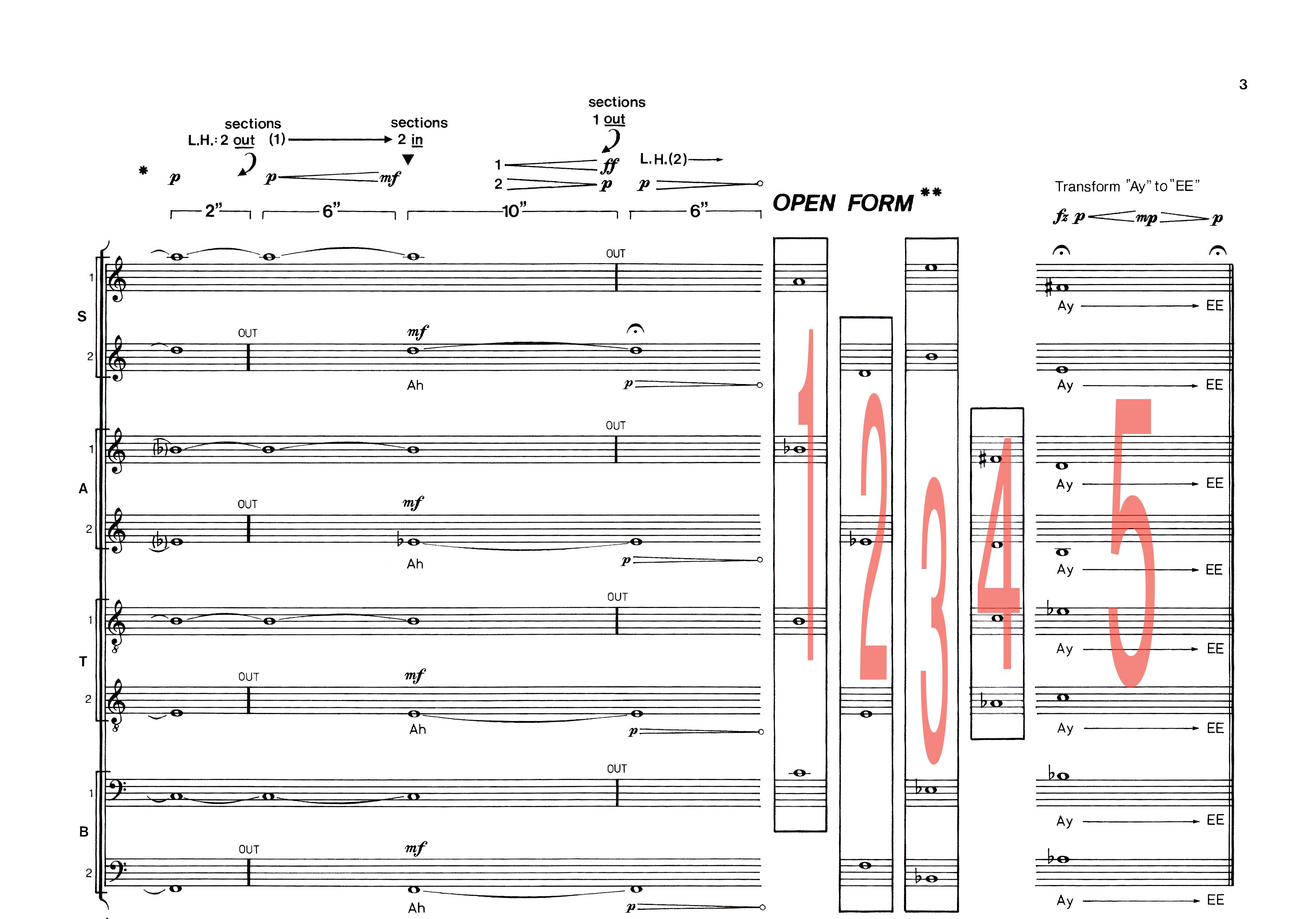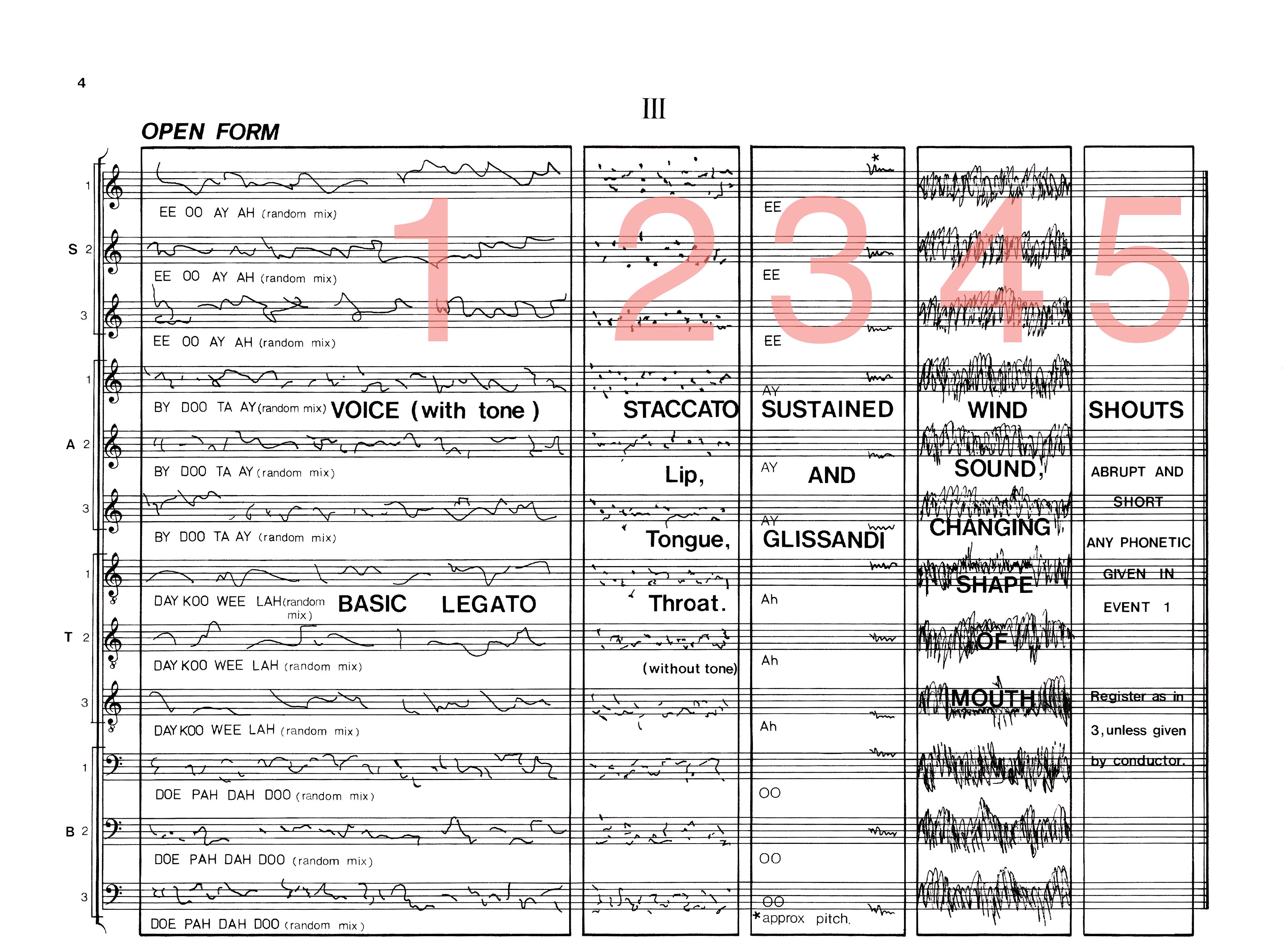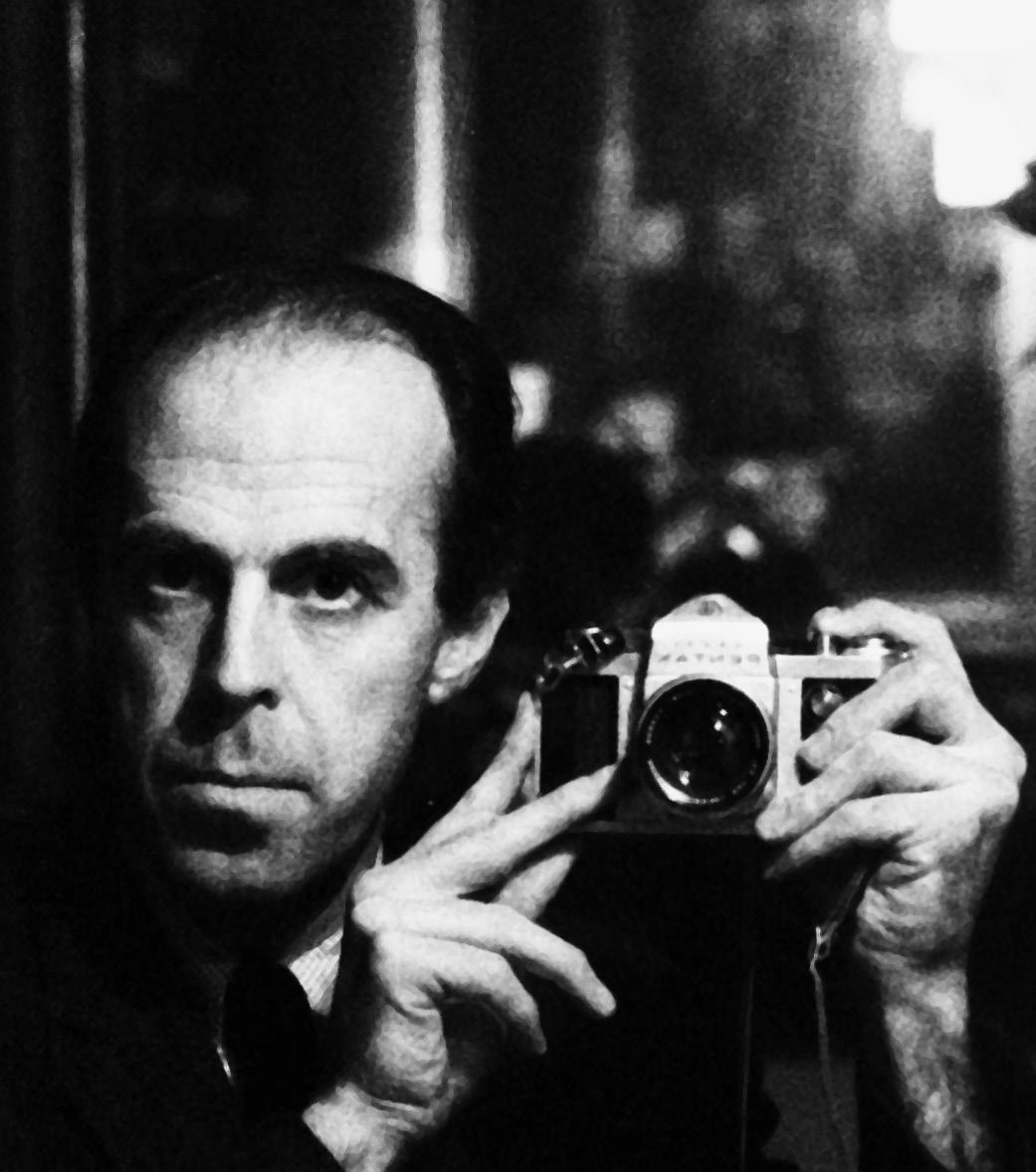BROWN
Small Pieces for Large Chorus




Dedicated to Richard Franko Goldman
For clarity of cueing, the four sections must be arranged:
Duration: variable
Among other things, the “Small Pieces” seem to confirm the fact that I am a “sound” rather than a “literary” composer; any poetry that I admire enough to think of as a text I admire too much to change the natural rhythm and pitch inflection that it has when it is simply read. These “texts,” therefore, are composed of simple vowel sounds, parts of words and vocal “noises.”
Of the three pieces, the first is on a phonetic text and the pitch is graphically indicated as a line-drawing; it begins as a 4 part, parallel ensemble cluster and becomes a polyphony of 4 independent parts. The second piece is precisely notated as to pitch and time and is basically a rather static study on two “chords” and sonic relationships and interferences between them. The third piece is “open form,” based on 5 different kinds of sound material. With the 4 sections (S.A.T.B.) it gives 20 elements that may be combined and juxtaposed as the conductor(s) wish, resulting in a different form for the piece in each performance.
IPage 1 , system 1 : all parts have the same material as the sopranos, but in their own characteristic registers.
System 2 : “shsss,” all parts ƒ p “HA Hiss Shh Hoo Kch.” This passage is as fast as possible but clearly articulated. All attacks are conducted. Flexibility between attacks is inevitable and must not be discouraged. II
Page 2 : each of the seven chords is conducted.
The first chord is 30 seconds, of which the last 4 seconds is a diminuendo ( P o ). Throughout this passage, the singers breathe normally when necessary, with no strain — but not together.
Page 3 : the last chord of page 2 is held for a further 2 seconds. The next signal (L.H.) removes all 2 nd sections; these are restored 6 seconds later. The last signal removes all first sections; 2 nd sections complete the phrase.
The following passage is “open-form.” The conductor controls the sequence of the chords, their juxtaposition, their duration and dynamics. The fingers of the left hand indicate the chosen chord. The size of the right hand down-beat (initiating the chord) indicates loudness.
The individual chord is stopped using the same procedure. Chords may be superimposed; a second may be introduced whilst the first continues. If any singers are thereby given more than one tone, they should sing both alternately, at a slow tempo, legato. A random mixture of vowels is used. The result should be spacious and relaxed.
Left hand “ 5 ” signals the final chord during which the vowel “AY” is slowly transformed to “EE.”
Page 4 is entirely “open-form.” The procedure is the same as before, though in this case there are five events to be manipulated, each of which may be individually stopped, or simply replaced: within a sequence of events, a new indication to the same section will automatically stop a previous one. Superimposition of events is possible if S.A.T.B. are cued independently. The conductor may also control register by varying the height of his left hand. Dynamics are indicated as before, by the size of the right hand down-beat.
The graphic notation clearly suggests the character of events 1 and 2 . In the first, the style is basically legato, each singer using a random mixture of vowels from those available. In the second: lip, tongue or throat sounds are required, (with no chest resonance), basically staccato.
The third event: sustained sounds and/or glissandi — the pitch indication is approximate. Glissandi up or down are indicated by raising or lowering the left hand.
Events 4 and 5 are self-explanatory.
In this third piece a second conductor could be designated from the chorus, to conduct two of the sections while the other conductor conducts the other two, i.e., conductor 1, sopranos and altos; conductor 2 , tenors and basses. Very rich juxtapositions of tempi, dynamics, textures and densities can be achieved.

Conductor: give each entrance (to entire ensemble in the case of first system; to individual sections in case of second system.)
The final sound of each phonetic is to be extended the full length of the graphic line.
*All parts have the same material, but in their own characteristic register . . it begins as a four part, parallel ensemble cluster.


All initial attacks of chords together, but during long fermata ( ) and thereafter, breathe normally when necessary, with no strain, but alternate breathing, so that pitches are always sustained by as many voices as possible.

*I suggest indicating section 2 by two fingers of L.H. and section 1 by one finger or R. H.
**RANDOM-MIXED VOWELS. Sequence, juxtaposition, duration and dynamics at discretion of conductor.
All events “HOLD until cut-off by conductor or until given another tone. If given more than one tone, sing both alternately at a slow tempo, legato.
Two Hand CUT-OFF means everyone. One hand CUT-OFF means ONLY the chord indicated by the L.H. fingers (1-4).

S.A.T.B. may be cued independently with different events. Events are indicated by left hand of conductor. Dynamics by conductor. Conductor may indicate (control) register by height of his left hand.

Earle Brown was born in 1926 in Lunenburg, Massachusetts, and in spirit remained a New Englander throughout his life. A major force in contemporary music and a leading composer of the American avantgarde since the 1950s, he was associated with the experimental composers John Cage, Morton Feldman and Christian Wolff, who – together with Brown – came to be known as members of the New York School. Brown died in 2002 at his home in Rye, New York.
Earle Brown wurde 1926 in Lunenburg, Massachusetts, geboren und blieb im Geist ein Leben lang Neuengländer. Ab den 1950er Jahren war er eine treibende Kraft in der zeitgenössischen Musik und einer der führenden Komponisten der amerikanischen Avantgarde. Enge Verbindung unterhielt er zu den experimentellen Komponisten John Cage, Morton Feldman und Christian Wolff, mit denen gemeinsam er später der sogenannten New York School zugerechnet wurde. Brown starb 2002 in seinem Haus in Rye, New York.